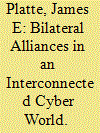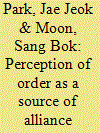| Srl | Item |
| 1 |
ID:
190074


|
|
|
|
|
| Summary/Abstract |
During the Cold War, US extended deterrence commitments mostly focused on deterring nuclear or strategic conventional attacks against allies in Europe and Asia. In the decades following the end of the Cold War in the early 1990s, the emergence of new technologies and domains for conflict, particularly the cyber domain, prompted new thinking for alliance management and extended deterrence. In this article I explore how the system of US bilateral alliances and informal strategic groupings in the Indo-Pacific affects the crafting of allied cyber deterrence strategies in the region. Based on deterrence and alliance theory, I survey cyber threats faced by US allies and partners in the region and views of cyber deterrence to form a general framework of allied cyber deterrence strategy. The US-South Korea alliance is used as a case study for allied cyber deterrence strategy, with a special focus on the impact that South Korea assuming wartime operational control of allied military forces could have on cyber deterrence on the Korean Peninsula. Just as concepts of extended deterrence had to evolve, the cyber domain will force the United States and allies to reconceptualize peacetime and wartime operational control.
|
|
|
|
|
|
|
|
|
|
|
|
|
|
|
|
| 2 |
ID:
131880


|
|
|
|
|
| Publication |
2014.
|
| Summary/Abstract |
The level of alliance cohesion is affected by the shift of attitudinal aspects (such as homogeneity in goals and threat perceptions) and behavioural aspects (such as strategic compatibility, command structure and defence burden-sharing) of alliance operation. In particular, a clear threat perception tends to make an alliance cohesive, as it suppresses (potential) disputes over the behavioural aspects of alliance operation. This article argues, however, that it is not sufficient to evaluate whether an alliance is cohesive or not only by looking at how these attitudinal and behavioural indicators have changed over time. If it were sufficient to do so, it would be supposed that the level of alliance cohesion would be bound to become lower with a change of government from conservative political forces to liberal ones in cases such as those of the US-ROK and the US-Japan alliances. We argue that the list of indicators for alliance cohesion should include not only attitudinal and behavioural aspects of alliance operation, but also functional aspects. While serving its primary purpose of responding to a specific threat, an alliance incurs an additional function of serving to maintain or to build a favourable regional order that is appreciated by both liberal and conservative governments. The interests in relation to order-building and order-maintenance motivate allies to invest for the alliance, often at their own political risk, even while they are engaged in contentious negotiations with the United States over attitudinal and behavioural aspects of alliance operations. Such investments can be considered as a different type of alliance burden sharing than has heretofore been given adequate attention. The investments indeed consolidate the alliance, paving the way for further upgrading of the alliance as conditions warrant.
|
|
|
|
|
|
|
|
|
|
|
|
|
|
|
|